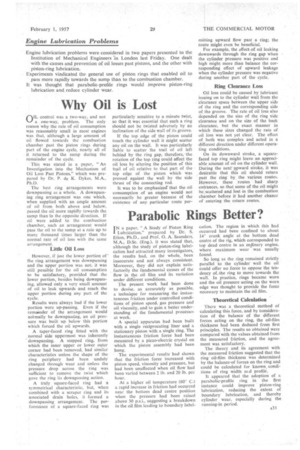Parabolic Rings Better?
Page 67

If you've noticed an error in this article please click here to report it so we can fix it.
IN a paper, "A Study of Piston Ring J. Lubrication," prepared by Dr. S. Eilon, Ph.D., and Prof. 0. A. Saunders, M.A., D.Sc, (Eng.), it was stated that, although the study of piston-ring lubrication had attracted many investigators, the results had, on the whole, been inaccurate and not always consistent. Moreover, they did not explain satisfactorily the fundamental causes of the flow in the oil film and its variation under different conditions.
The present work had been done to devise, as accurately as possible, a technique for measuring the instan. taneous friction under controlled conditions of piston speed, gas pressure and oil viscosity, and to gain a better understanding of the fundamental processes at work.
A special apparatus had been built with a single reciprocating liner and a stationary piston with a single ring. The instantaneous friction force had been measured by a piezo-electric crystal on which the piston assembly had been hung, • The experimental results had shown that the friction force increased with piston speed, viscosity and pressure, but had been unaffected when oil flow had been varied between 2 lb. and 20 lb. per hour.
At a higher oil temperature (60° C.) a rapid increase in friction had occurred near the bottom dead centre position when the pressure had been raised above 30 p.s.i., suggesting a breakdown in the oil film leading to boundary lubri cation. The region in which this had occurred had been confined to about 14° crank angle at the bottom dead centre of the rig, which corresponded to top dead centre in an ordinary engine, where maximum wear was usually found.
So long as the ring remained strictly parallel to the cylinder wall the oil could offer no force to oppose the tendency of, the ring to move towards the wall. In practice, rings became worn and the oil pressure acting on the worn edge was thought to provide the force necessary to maintain the oil film.
Theoretical Calculation
There was a theoretical method of calculating this force, and by Consideration of the balance of the different forces acting on the ring, the oil-film thickness had been deduced from first principles. The results so obtained were compared with the values obtained from the measured friction, and the agreement was satisfactory.
The theory and its agreement with the measured friction suggested that the ring oil-film thickness was determined by the balance.of forces on the ring and could be calculated for known conditions of ring width al,d profile.
it appeared that the adoption of a parabolic-profile ring in the first instance could improve piston-ring lubrication, reducing the extent of boundary lubrication, and thereby cylinder wear, especially during the running-in period.




































































































